In today’s rapidly evolving digital landscape, the role of artificial intelligence (AI) in cybersecurity cannot be overstated. As businesses and organisations increasingly rely on digital technologies to drive innovation and growth, they are also becoming more vulnerable to cyber threats. In this article, we will explore how AI is revolutionising cybersecurity, both as a powerful defensive tool and as a driving force behind the evolution of cyber threats.
AI in Defensive Cybersecurity Measures:
AI has emerged as a game-changer in the field of cybersecurity, empowering organisations to detect and respond to threats with unprecedented speed and accuracy. By leveraging machine learning algorithms, AI-powered security solutions can analyse vast amounts of data in real-time, identifying patterns and anomalies that may indicate potential cyber attacks.
One of the key advantages of AI in cybersecurity is its ability to adapt and learn from new data, allowing security systems to continuously improve and stay ahead of emerging threats. From intrusion detection and threat hunting to malware analysis and incident response, AI-driven security solutions are reshaping the way organisations defend against cyber threats.
However, while AI holds tremendous promise for enhancing defensive cybersecurity measures, it also presents new challenges and risks. As cyber criminals increasingly weaponise AI to launch more sophisticated and targeted attacks, organisations must remain vigilant and proactive in their cybersecurity efforts.
The Evolution of AI-Driven Cyber Threats:
The rise of AI has ushered in a new era of cyber threats, characterised by highly automated and intelligent attack techniques. Cybercriminals are harnessing the power of AI to develop advanced malware, conduct sophisticated phishing campaigns, and orchestrate large-scale cyber attacks with unprecedented speed and precision.
For example, AI-powered malware can evade traditional security defenses by constantly morphing and adapting its behaviour to evade detection. Similarly, AI-driven phishing attacks can generate highly convincing fake emails that are indistinguishable from legitimate communications, making them more likely to deceive unsuspecting users.
Moreover, the proliferation of AI-powered hacking tools and exploit kits has lowered the barrier to entry for cybercriminals, enabling even novice attackers to launch sophisticated cyber attacks with minimal effort.
Navigating the Storm:
As organisations navigate the complex landscape of cybersecurity in the AI era, it is essential to adopt a multi-faceted approach to security. This includes implementing robust AI-driven security solutions to defend against emerging threats, as well as investing in employee training and awareness programs to mitigate the risk of human error.
Additionally, organisations must prioritise data privacy and compliance efforts to ensure that sensitive information is adequately protected against unauthorised access and misuse. By taking a proactive and holistic approach to cybersecurity, organisations can effectively navigate the storm of AI-driven cyber threats and safeguard their digital assets in today’s interconnected world.
In conclusion, AI is revolutionising cybersecurity by providing organisations with powerful defensive capabilities, while also posing new challenges and risks. By understanding the dual-edge nature of AI technology in cybersecurity, organisations can proactively adapt their security strategies to stay ahead of emerging threats and protect their digital assets in the face of evolving cyber risks.










